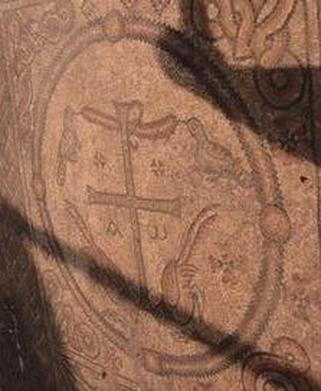 Image: Taken from Yahoo! News, Jan. 24th 2014
Image: Taken from Yahoo! News, Jan. 24th 2014 In a Yahoo! news article reporting the discovery (appearing originally on LiveScience), excavator Davida Eisenberg Degen claims the christogram is a "type of monogram of the name of Jesus," but this is incorrect. That same Yahoo! news article claims that the christogram is a "like a 'chi rho' symbol, which puts together the first two captial [sic] letters in the Greek word for Christ, and often looks like an X superimposed on a P." Later in the news article, the author refers to the symbol as a "chi rho." This description is also incorrect, as it is not a "chi-rho" device at all. Rather, this symbol is a stand-alone staurogram that occurs quite frequently in early Christian art and manuscripts. The tau-rho compendium is formed by superimposing the Greek letter rho onto the tau.
From what we can observe, it seems that in its earliest form the staurogram was written by Christian scribes as part of a nomen sacrum ("sacred name") for the words "cross" (σταύρος) and "crucify" (σταυρόω) in reference to Jesus' death on the cross. But the symbol eventually came to be used as a standalone visual reference to Jesus' crucifixion, which is precisely what we have here in the floor mosaic discovered in Aluma. Here is an example of a standalone staurogram or tau-rho device:
The find is certainly significant and my comments are not meant to detract from it. But the explanations and designations of this device are incorrect and I would encourage the media to consult scholars for additional opinions on such matters before taking it straight to the public. For those interested in learning more about the Christian staurogram, see chapter 4 in Larry W. Hurtado, The Earliest Christian Artifacts: Manuscripts and Christian Origins (Grand Rapids: Eerdmans, 2006).


